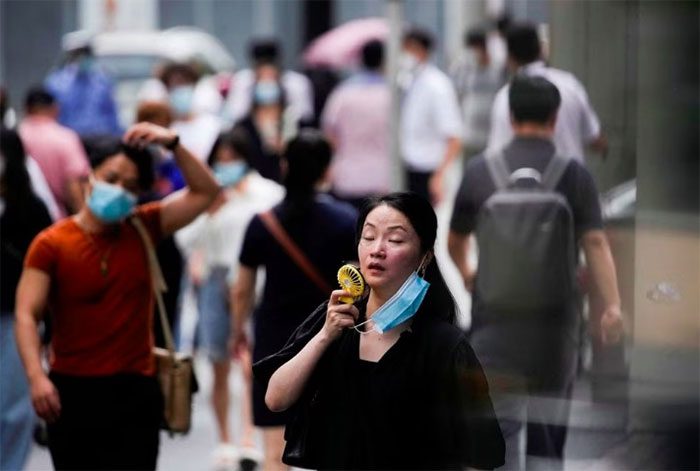Climate scientists from the University of Bristol indicate that heat stress could reach levels where all humans, even healthy and well-adapted individuals, may not survive.
According to Channel News Asia, this year, even before summer began in the Northern Hemisphere, temperature records have continuously been shattered.
For instance, Spain reported an unusually high temperature of 38.8 degrees Celsius, even during the peak of summer. Southeast Asia, in particular, has been affected by prolonged heat waves and record temperatures, with Vietnam and Thailand experiencing highs of 44 and 45 degrees Celsius, respectively.

The intense heat waves currently are causing very different impacts.
In Singapore, a more modest record was also broken, with temperatures reaching 37 degrees Celsius. Meanwhile, in China, Shanghai recorded its hottest May day in over a century at 36.7 degrees Celsius.
Experts suggest that climate change may have contributed to higher temperatures, but the intensity of the current heat waves is causing very different impacts depending on various factors.
Weather and Physiology
The recent heat wave in Southeast Asia may be remembered for its level of heat stress – the stress caused by heat on the body. Heat stress is primarily induced by temperature, but other weather-related factors such as humidity, radiation, and wind are also significant contributors.
Our bodies absorb heat from the surrounding air, from the sun, or from processes such as digestion and exercise. To cope with heat waves, the human body will lose some amount of heat. The heat generated by the body is released into the air and some is expelled through breathing. However, most heat is lost through sweating, as sweat on the skin’s surface evaporates, taking energy from the skin and the surrounding air in the form of “latent heat.”
Meteorological factors affect all of these processes. For example, lack of shade exposes the body to direct heat from sunlight, while higher humidity reduces the evaporation rate of sweat on the skin. High humidity also increases risks for humans during recent heat waves in Southeast Asia, as this is already one of the most humid regions in the world.
Limits of Heat Stress

A woman uses a fan in Shanghai, China during the record heat wave. (Photo: Reuters).
Pre-existing health conditions and different body states can make some individuals more susceptible to heat stress. However, heat stress can reach a threshold beyond which all individuals – even those who are healthy and well-adapted – may not survive, even with moderate exertion.
There is a way to assess the level of heat stress – known as wet bulb globe temperature (WBGT) – an index representing the heat stress that an individual is exposed to.
In prolonged hot conditions, temperatures close to 39 degrees Celsius combined with 50% relative humidity represent this threshold. This limit may have been exceeded in some areas during the recent heat wave across Southeast Asia.
In less humid areas far from the tropics, humidity will be lower and thus the WBGT will also be lower and considerably less dangerous.
The April heat wave in Spain with a maximum temperature of 38.8 degrees Celsius had a WBGT value of only about 30 degrees Celsius. During the 2022 heat wave in the UK, temperatures exceeded 40 degrees Celsius, with humidity below 20% and a WBGT around 32 degrees Celsius.
Scientists have used climate data to map heat stress levels worldwide. The research highlights that regions at highest risk of exceeding the highest WBGT thresholds include hotspots – such as India and Pakistan, Southeast Asia, the Arabian Peninsula, equatorial Africa, equatorial South America, and Australia. In these areas, the heat stress threshold is exceeded with increasing frequency alongside greater global warming.
In reality, humans are very vulnerable below the survivable threshold. This is why we may see the death toll from heat waves in cooler places significantly higher.
Moreover, global analyses often fail to capture extreme factors caused by microclimate processes. For example, a certain residential area in a city may retain heat more effectively than the surrounding area, or it may be ventilated by cool sea breezes, or be located in the “rain shadow” of a local hill, making that area less humid.
Adaptation and Resilience

Heat waves of similar intensity can have very different impacts depending on factors such as humidity. (Photo: iStock).
Tropical regions often experience less temperature variability. For example, Singapore is almost on the equator with maximum temperatures around 32 degrees Celsius year-round, while typical maximum temperatures in London during midsummer are only 24 degrees Celsius. Yet, London has recorded higher record temperatures (40 degrees Celsius compared to 37 degrees Celsius in Singapore).
Given that regions like Southeast Asia consistently experience high levels of heat stress, it may suggest that people will adapt well to cope with this weather phenomenon.
Initial reports indicate that the high heat stress from the recent heat wave has led to some surprising direct fatalities. However, there have yet to be accurate reports on indirect causes of death.
The research emphasizes that even without climate change, natural weather variability can create heat waves that break local records, potentially nearing physiological limits, which can be a very risky endeavor.


















































